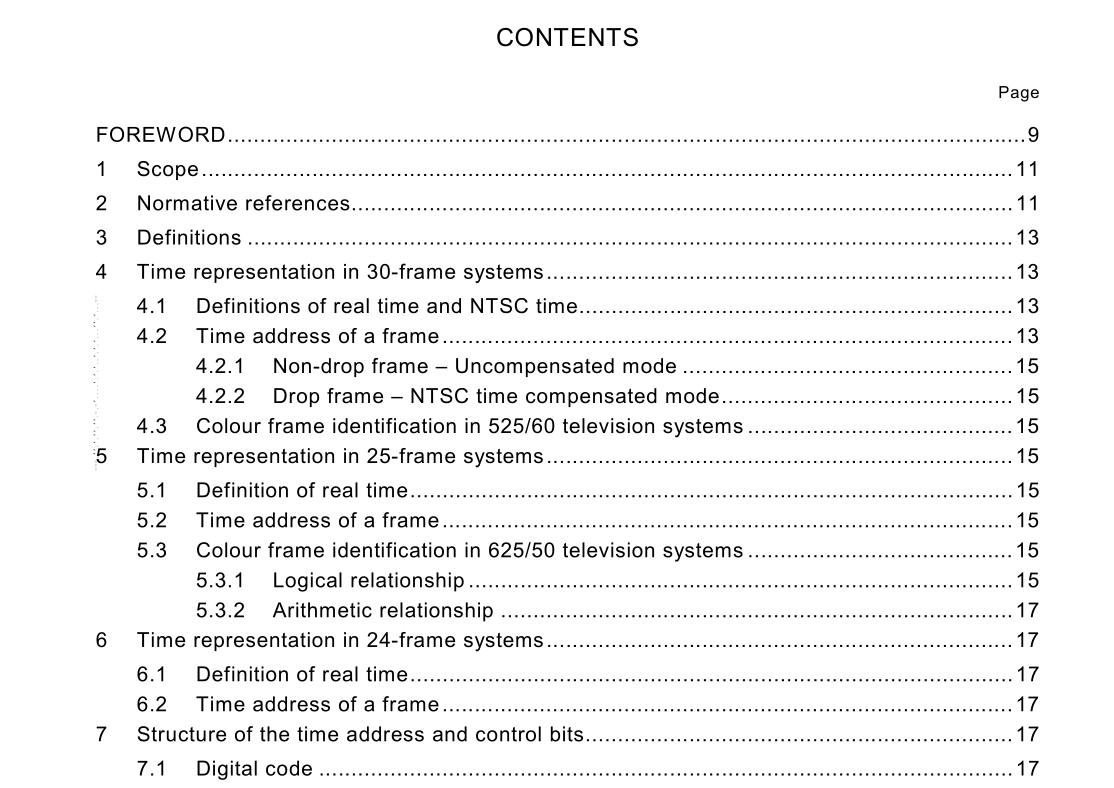IEC 60461 pdf download

IEC 60461 pdf download.Time and control code for video tape recorders
1 Scope
This International Standard specifies a digital time and control code for use in television, film, and accompanying audio systems operating at 30, 25, and 24 frames per second. Clauses 4, 5, and 6 specify the manner in which time is represented in frame-based systems. Clause 7 describes the structure of the time address and control bits of the code, and sets guidelines for storage of user data in the code. Clause 8 specifies the modulation method and interface characteristics of a linear time code (LTC) source. Clause 9 specifies the modulation method for inserting the code into the vertical interval of a television signal. Clause 10 summarizes the relationship between the two forms of time and control code
2 Normative references
The following normative documents contain provisions which, through reference in this text, constitute provisions of this International Standard. For dated references, subsequent amendments to, or revisions of, any of these publications do not apply. However, parties to agreements based on this International Standard are encouraged to investigate the possibility of applying the most recent editions of the normative documents indicated below. For undated references, the latest edition of the normative document referred to applies. Members of IEC and ISO maintain registers of currently valid International Standards. ISO/IEC 646:1991, Information technology – ISO 7-bit coded character set for information interchange ISO/IEC 2022:1994, Information technology – Character code structure and extension techniques SMPTE 170M:1999, Television – Composite Analog Video Signal – NTSC for Studio Applications SMPTE 240M:1995, Television – Signal Parameters – 1125-Line High-Definition Production Systems SMPTE 258M:1993, Television – Transfer of Edit Decision Lists SMPTE 262M:1995, Television, Audio and Film – Binary Groups of Time and Control Codes – Storage and Transmission of Data SMPTE 309M: Television – Transmission of Date and Time Zone Information in Binary Groups of Time and Control Code SMPTE RP 164:1996, Location of Vertical Interval Time Code ITU-R BT.470-6:1994, Conventional Television Systems
3 Definitions
For the purpose of this International Standard, the following definitions apply: 3.1 linear time code (LTC) linear time code modulation system (previously referred to as the longitudinal track application of time and control code) 3.2 vertical interval time code (VITC) modulation system used to insert the time code signal in the vertical blanking interval of a television signal 3.3 source any device which generates a time and control code signal, or regenerates a time and control code signal from a recorded medium or transmission channel An original source refers specifically to the device which is generating the time and control code signal.
4 Time representation in 30-frame systems
4.1 Definitions of real time and NTSC time 4.1.1 In a system running at a frame rate of 30 frames per second, exactly one second of real time elapses during the scanning of 30 frames. An example of such a system is an 1125/60 high-definition system. 4.1.2 In an NTSC television system running at a vertical field rate of 60/1,001 fields per second (≈ 59,94 Hz), one second of NTSC time elapses during the scanning of 60 television fields or 30 television frames. Because of the difference in vertical scanning rates,4.2 Time address of a frame Each frame shall be identified by a unique and complete address consisting of an hour, minute, second, and frame number. Refer to SMPTE 258M for standard formats used to display frame- based time. The hours, minutes, and seconds follow the ascending progression of a 24-hour clock beginning with 0 hours, 0 minutes, and 0 seconds to 23 hours, 59 minutes, and 59 seconds. The frames shall be numbered successively according to the counting mode (drop frame or non-drop frame) as described below:4.2.1 Non-drop frame – Uncompensated mode Frames shall be numbered 0 through 29, successively, with no omissions. 4.2.2 Drop frame – NTSC time compensated mode Because the vertical field rate of an NTSC television signal is 60/1,001 fields per second (≈ 59,94 Hz), straightforward counting at 30 frames per second will yield an error of approximately +108 frames (+3,6 s) REAL in one hour of running time. To minimize the NTSC time error, the first two frame numbers (00 and 01) shall be omitted from the count at the start of each minute except minutes 00, 10, 20, 30, 40, and 50. When drop-frame compensation is applied to an NTSC television time code, the total error accumulated after one hour is reduced to –3,6 ms. The total error accumulated over a 24-hour period is –86 ms.









